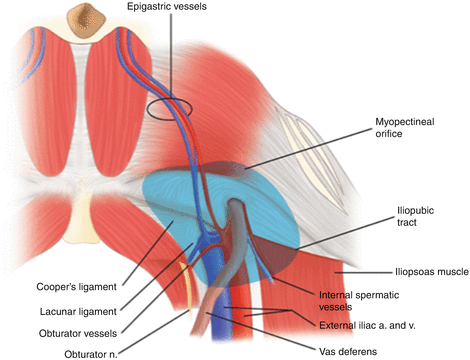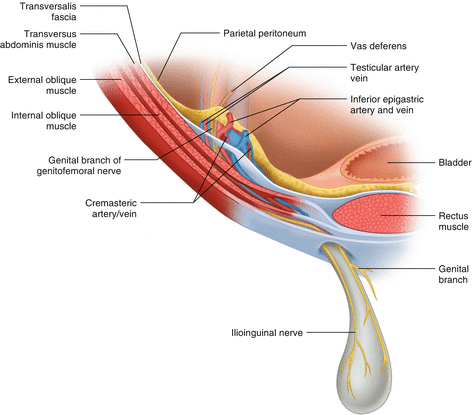Fig. 2.1.
Borders of the inguinal canal (from Wagner et al. [1], with kind permission © McGraw-Hill Education).
Fascial Layers and the Inguinal Rings
In order to understand the course of the various structures that enter and exit the inguinal canal, listed in Table 2.1, the fascial layers and their openings must first be conceptualized. In the male, the internal ring is an opening in the transversalis fascia through which the vas deferens enters on its course from the pelvis. The vas meets the gonadal vessels and the genital branch of the genitofemoral nerve as they approach from an inferolateral direction and picks up the cremasteric artery as it branches off the inferior epigastric artery. These comprise the cord structures that are covered by the internal spermatic fascia, formed from the connective tissue of the transversalis fascia. Fibers from the internal oblique form a second covering of the cord, the cremaster muscle, and cremasteric fascia. In the female, the internal ring transmits the round ligament, which suspends the uterus anteriorly, and the genital branch of the genitofemoral nerve. The cord structures that approach and pass through the internal ring are best appreciated from the laparoscopic view, which is illustrated in Fig. 2.2 [1].

Table 2.1.
Structures of the inguinal canal.
Vas deferens (or round ligament) |
Artery to the vas Gonadal artery Cremasteric artery |
Cremasteric vein Gonadal vein (pampiniform plexus) |
Genital branch of genitofemoral nerve Ilioinguinal nerve Sympathetic nerves |
Lymphatics |
Internal spermatic fascia Cremasteric fascia and muscle External spermatic fascia |

Fig. 2.2.
Laparoscopic view of the internal ring (from Wagner et al. [1], with kind permission © McGraw-Hill Education).
The external ring is a triangular opening in the aponeurosis of the external oblique muscle. To form the external ring, the aponeurosis splits into a lateral crus, which attaches to the pubic tubercle, and a medial crus attached to the pubic crest. The two crura are held together by intercrural fibers at the apex of the triangular opening. The ilioinguinal nerve and the cord structures destined for the scrotum (or the round ligament into the labium majus in the female) pass through the external ring where fibers from the external oblique continue downward to form the third covering of the cord, the external spermatic fascia.
Some authors refer to a “third ring” which is deep and slightly lateral to the internal ring, and is formed by an opening in the preperitoneal fascia [2, 3]. This ring transmits the gonadal vessels and the vas from the visceral space of the preperitoneum into the parietal space of the preperitoneum, where they are joined by the genital branch of the genitofemoral nerve. These fascial planes and spaces, and the structures they contain, are illustrated from an axial view in Fig. 2.3. Mesh placement during laparoscopic repair should be in the visceral compartment; incorrect placement in the parietal preperitoneal space is a potential cause of postoperative pain because the mesh may directly contact the genital and/or femoral branches of the genitofemoral nerve and the lateral femoral cutaneous nerve [1].







